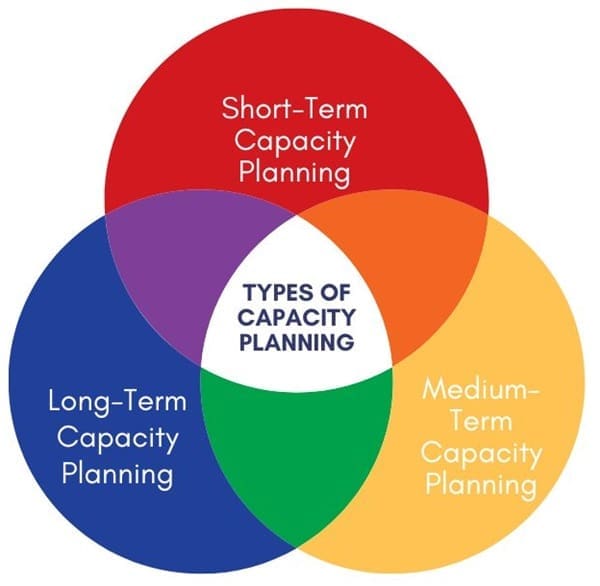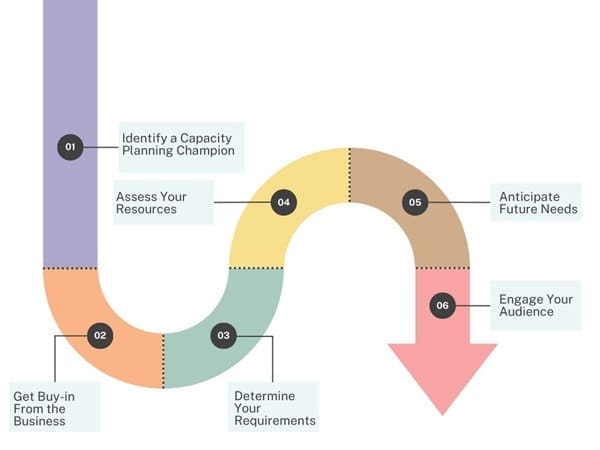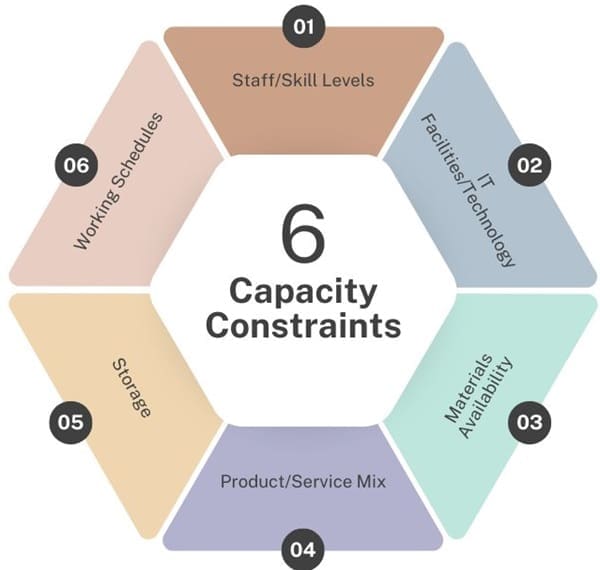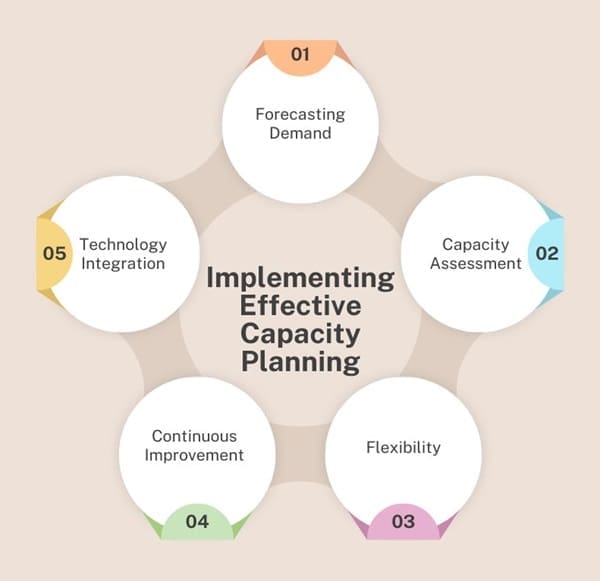Capacity planning is a fundamental element of operations management, shaping a facility’s productive capability and impacting nearly every aspect of operations from optimal production levels to uninterrupted production runs. This comprehensive guide delves into its key concepts, types, measurement methods, strategies, activities and overall impact.
Table of contents
- What Is Capacity Planning?
- Meaning of Capacity
- Capacity Planning Strategies
- Importance of Capacity Planning
- Capacity Planning Activities
- Benefits of Capacity Planning
- Types of Capacity Planning
- Steps in Capacity Planning
- Process for Capacity Planning
- Measuring Capacity
- Capacity Constraints
- Capacity Management
- Final Words
- Related Articles
What Is Capacity Planning?
Capacity planning is an essential practice for businesses that aim to meet future demand with adequate resources. This involves estimating production capacity needs in response to evolving customer preferences for its products or services and ensures maximum operational efficiency by not under or overutilizing resources.
Public, Onsite, Virtual, and Online Six Sigma Certification Training!
- We are accredited by the IASSC.
- Live Public Training at 52 Sites.
- Live Virtual Training.
- Onsite Training (at your organization).
- Interactive Online (self-paced) training,
Meaning of Capacity
Capacity refers to the upper limit or ceiling on how much an operating unit, such as a plant, department, machine, store, worker or worker can handle in terms of inputs (labour hours or raw materials) or outputs (units produced).
Types of Capacity
- Design Capacity: The maximum output a facility can reach under ideal conditions.
- Effective Capacity: Given constraints such as product mix, maintenance issues and scheduling considerations, the maximum output available.
- Actual Output: The actual output achieved, typically less than effective capacity due to various disruptions.
Measuring Capacity
Measurement of capacity should be accurate depending on each situation – typically using factors like labour hours, machine hours and the number of cars per shift as measures of capacity.
- Auto Manufacturers: They use labour hours, machine hours and a number of cars per shift as common measures of capacity measurement.
- Steel Mills: Furnace size and tons of steel produced daily.
- Oil Refineries: Refinery size and fuel consumed each day.
- Farming: Acreage used, number of cows on an acre, bushels per acre produced, daily milk yield per day produced per cow and more.
- Restaurants: Number of tables with seating capacities available and meals served every day.
- Theatres: Number of seats sold per performance and revenue generated per day.
- Retail Sales: Square feet of floor space sold and revenue generated per day.
Also Read: What is Material Requirement Planning?
Capacity Planning Strategies

Companies typically utilize one of three primary strategies when planning capacity:
Lead Strategy: Increase production capacity ahead of expected demand to capture market share, although this strategy can be risky if demand does not materialize as projected.
Lag Strategy: Adds capacity after demand has increased to limit excess inventory while at the same time potentially losing customers due to delayed response times.
Match Strategy: Incrementally adjusts capacity based on market conditions to balance risk and responsiveness.
Importance of Capacity Planning

Capacity decisions are vitally important for multiple reasons:
- Meeting Future Demand: Ensuring you can meet future product and service demand while capitalizing on market opportunities.
- Matching Capacity with Demand: Aligning capacity with demand can reduce operating costs significantly.
- Initial Costs: Decisions about capacity affect initial investment costs, typically necessitating significant financial commitment.
- Long-Term Commitment: Once implemented, changing capacity decisions can be expensive and time-consuming to undo.
- Competitiveness: Adequate or flexible capacity can serve as a barrier to entry for competitors.
- Management Ease: Optimized alignment reduces management complexity.
- Globalization Impact: Distant markets and supply chains add an additional level of complexity when planning capacity needs.
- Long-Range Planning: Facilities that take years to become operational require accurate long-range capacity planning in order to become functional.
Capacity Planning Activities
- Assess Existing Capacity: Evaluate current capacity using metrics like efficiency and utilization.
- Project Future Needs: Anticipate short- and long-term demand to estimate capacity needs in advance.
- Adjusting Capacity: Consider ways of increasing capacity through inventory management, employment adjustments, process redesign and subcontracting.
- Evaluating Alternatives: Evaluate each capacity option according to financial and technological considerations to select the most viable capacity option.
- Implementing Capacity Decisions: Select an ideal strategy and plan its execution.
Also Read: What is Simulation?
Benefits of Capacity Planning
Optimized Resource Utilization: By accurately forecasting demand, businesses can ensure that resources such as machinery, labor and raw materials are utilized optimally – thus avoiding under-utilization (with associated wasted costs and resources) or overutilization (leading to burnout and potential shortages).
Improved Service Quality: Ensuring adequate capacity is available is vital in upholding high service levels, decreasing wait times, and improving overall customer satisfaction.
Cost Management: Careful capacity planning can assist with cost control by eliminating expenses associated with maintaining excessive capacity or penalties associated with inadequate capacity.
Improved Business Agility: Capacity plans allow companies to quickly adapt to changing market conditions or customer requirements by having an effective capacity plan in place.
Types of Capacity Planning

- Short-Term Capacity Planning: Targets immediate needs within several months. This could involve minor adjustments such as changing work shifts or hiring temporary staff as temporary solutions to satisfy demand spikes.
- Medium-Term Capacity Planning: Covers two years. It involves more extensive changes such as purchasing new equipment, increasing workforce sizes or initiating marketing campaigns in order to drive increased demand.
- Long-Term Capacity Planning: Long-term capacity planning involves making strategic decisions that have an impactful effect over an extended period. These may include building new facilities, entering new markets or making significant technological upgrades.
Steps in Capacity Planning

Step 1: Identify a Capacity Planning Champion: Assign someone to lead capacity planning efforts. This capacity planning champion will outline the strategy, drive the initiative, and coordinate with various departments to ensure everyone is involved.
Step 2: Get Buy-in From the Business: Secure early business buy-in by emphasizing the benefits of capacity planning such as improved service quality, enhanced efficiency and closer alignment between IT and business needs. This makes gathering information and support necessary for capacity planning efforts much simpler.
Step 3: Determine Your Requirements: Establish performance and availability requirements using Service Level Agreements (SLAs). Common examples of SLAs might include uptime requirements, response times and hourly throughput rates. When reviewing SLAs carefully make sure to include specific performance metrics related to individual components mapped with them.
Step 4: Assess Your Resources: Accumulate and analyze performance data to detect patterns such as seasonality, correlations in use or underutilized or overburdened systems – helping establish a baseline and identify any issues or potential threats to success.
Step 5: Anticipate Future Needs: Plan for future capacity needs by engaging the business to gain an accurate picture of expectations and verify these against historical demand patterns. Afterwards, use an effective capacity planning method to examine how anticipated demands could potentially alter performance and availability.
Step 6: Engage Your Audience: Engage and influence both IT and business audiences by tailoring your message accordingly for each group, such as offering technical insights for technical teams while emphasizing strategic value to business teams. Effective communication ensures organizational alignment and commitment towards your capacity planning strategy.
Process for Capacity Planning
Capacity Planning in general comprises eight steps:
- Assess Current Situation: Evaluate your company’s environment to predict future demands by considering technology, competition and other events that could have an effect.
- Determine Available Capacity: Assess current resources and capabilities.
- Translate Predictions into Physical Requirements: Translate future demand predictions into specific capacity needs for future demand predictions.
- Develop Alternative Plans: Strategize ways of matching required capacity with available capacity.
- Analyze Economic Effects: Evaluate the financial ramifications of each plan.
- Analyze Risks: Consider the risks and strategic consequences of each alternative plan.
- Select an Appropriate Course of Action Based On Analysis: Select the most viable plan after conducting a thorough analysis.
- Implement the Plan: Once your strategy has been chosen, implement it ensuring all stakeholders are engaged.
Measuring Capacity
Capacity can be assessed using either input or output metrics:
Input Measures of Capacity
Input measures provide an analysis of key inputs into a process, such as rooms in a hotel or seats at a conference venue. They can be useful when dealing with small processes with fixed capacity requirements or highly customized services that have specific demands.
Output Measures of Capacity
Output measures count the completed units from a process, such as cars produced per week or bottles filled per day, making these the optimal way to assess production with limited product variety or customization requirements. Our Example Process
- Music Festivals: Input = square meters of land; Output = number of attendees.
- Hotels: Input = rooms available; Output = total guests per week.
- Car Manufacturing Plants: Input = machine capacity; Output = vehicles produced every month.
- Milk Bottling Plant: Input = machine hours and output = bottles filled per day.
Also See: LEAN Management in Healthcare
Capacity Constraints

A capacity constraint is any resource that limits throughput within an operation and identifying and addressing these constraints can significantly enhance overall capacity. Common limitations could include:
- Staff/Skill Levels: Training staff to be more nimble and productive can boost capacity, as can cross-training employees to ensure that an absent employee doesn’t hinder production processes.
- IT Facilities/Technology: Investing in technology can both reduce process times and expand capacity, such as upgrading servers to faster, more reliable servers which enhance IT service performance.
- Materials Availability: Enhancing the availability of raw materials is key to increasing capacity, including finding reliable suppliers or increasing inventory levels to prevent production delays.
- Product/Service Mix: Varying the mix can help maximize resource use. For instance, prioritizing high-demand items during peak seasons to maximize output.
- Storage: Adequate storage can help smooth out fluctuations in demand. Having enough warehouse space ensures production continues uninterrupted if demand temporarily decreases.
- Working Schedules: Extending work hours or optimizing schedules to increase capacity can dramatically expand a manufacturing plant’s output; for instance, adding an extra shift could double output.
Capacity Management
Capacity management involves ensuring that the operation can transform inputs into outputs at the desired rate. It includes managing the number of units (goods or services) produced over a given period under normal working conditions without additional resources. Common capacity measurements include:
- Number of Passengers per Flight: For airlines.
- Number of Patients per Surgery Session: For medical practices.
- Number of Mobile Phones Produced per Week: For manufacturing.
Challenges in Capacity Management
- Demand/Provision Balancing: Keeping customer demand in balance with provision can be an ongoing challenge for companies, so companies must ensure they have enough capacity to meet peak demands without incurring unnecessary expenses during times of lower demand.
- Economic Considerations: Companies must assess the costs involved with increasing or decreasing capacity, taking into account both satisfying customers and production costs when making this decision. Under-utilized resources represent wasted resources while insufficient capacity may lead to missed opportunities or dissatisfied customers – both situations require careful management for optimal success. To successfully plan for the expansion or contraction of capacity it is vital that firms utilize accurate capacity planning strategies.
Also Read: Who is a Quality Engineer?
Implementing Effective Capacity Planning

There are several steps involved in implementing effective capacity planning.
- Forecasting Demand: To accurately anticipate future demand, draw on historical data, market trends and business insights as a source.
- Capacity Assessment: Regularly review current capacity levels to detect bottlenecks that might limit growth.
- Flexibility: Plan for quick adaptation to unexpected demand changes by building flexibility into your capacity planning processes.
- Continuous Improvement: Revamp your capacity planning procedures regularly to enhance accuracy and efficiency.
- Technology Integration: Leverage the latest tools and technologies for data collection, analysis, and forecasting to enhance capacity planning.
Final Words
Capacity planning is an essential discipline that ensures businesses can meet future demand efficiently. By following a structured process and accurately measuring capacity, organizations can optimize their operations while better-aligning IT and business goals. Successful capacity planning not only optimizes resources and cost management but also enhances service quality and business agility – an indispensable aspect of any successful business strategy.

About Six Sigma Development Solutions, Inc.
Six Sigma Development Solutions, Inc. offers onsite, public, and virtual Lean Six Sigma certification training. We are an Accredited Training Organization by the IASSC (International Association of Six Sigma Certification). We offer Lean Six Sigma Green Belt, Black Belt, and Yellow Belt, as well as LEAN certifications.
Book a Call and Let us know how we can help meet your training needs.




















